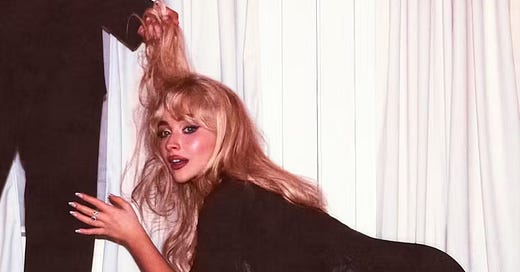📝 Before We Begin
I have been trying to finish this piece about Sabrina Carpenter and Choice Feminism ALL WEEK. And every time I think I get close, more thoughts arise and more deviations and I’m sorry for the delay I AM JUST AS FRUSTRATED AS YOU!
There’s so much to unpack here, and most of it has nothing to do with a famous pop star and her generically “sexy” artistic stylings. I want to write about how “choice” became the central tenet of a feminism that has been virtually stripped of all meaning, upheld mostly by white women raised in a culture that prioritised individualism, capitalist gains and the corporate branding of feminism as Girl Power.
But this is a HUGE conversation, and I’m finding it impossible to get to the meat of it without covering at least some of my thoughts on that cover, the conversation it provoked and what it says about people’s understanding of feminism in 2025.
So I’m going to break this topic down into parts and share them in separate posts. This first post is largely about Carpenter and how feminism under capitalism is still prioritising the individual gains of certain women over the interests of the collective. I warn you - it is VERY LONG.
Later this week, I’ll share a piece I’ve been simultaneously writing about the origins of the term “choice feminism” and how the embrace of it as a practice was in part facilitated by what Susan Faludi theorised as the backlash. There may be a third piece to follow, but we’ll see if I can cover what I want to say just in that!
There’s also a GIVEAWAY in this edition, and you can find that at the bottom! This giveaway is for paid subscribers only, and will be regular feature. Gotta be in it to win it!
Let’s get to it.
🧠 The Think Piece:
Empowered™: Please, please, please stop it
“Feminism insists on methods of thought and action that urge us to think about things together that appear to be separate, and to disaggregate things that appear to naturally belong together.”
- Angela Davis, Freedom is a Constant Struggle: Ferguson, Palestine and the Foundations of a Movement
Two weeks have passed since Sabrina Carpenter launched a million hot takes by dropping the provocative cover of her new album, Man’s Best Friend.
Given that today’s cultural ‘discourse’ (and my god do I hate that word) moves with lightning speed (and frequently superficial depth, like a polished rock skips across the surface of a lake before sinking to oblivion), it might seem strange that I’m writing about it now. Didn’t that happen, like, twelve years ago?
Don’t worry, I’m not going to rehash any of the arguments you might have already seen. I’m not especially interested in debating the merits of whether or not this is ‘satire’, nor am I invested in prosecuting Carpenter for crimes against women.
But if you’re curious to read more on either of those things, I followed a lot of good commentary on Threads and education, particularly that contributed by Black women and writers. Having misspoken and misstepped so many times in the past on topics I didn’t properly understand as a younger feminist, I’m trying harder these days to hold my tongue until I feel I’ve read beyond what my instinct or own experience can tell me. It doesn’t always mean that my instinct is wrong, but intersectionality isn’t just a word or label we can claim for ourselves - like most things in life, it’s a practice.
Given the exasperated repetition that anyone who expressed alarm over the album cover “lacked critical thinking skills” (despite few people really explaining why not liking it meant you just didn’t understand it), it’s probably worth considering how we incorporate critical thinking into our own practice. If you’re a white woman reading this, one thing I’d recommend we all become proficient at when analysing a topic is remembering an audience exists well beyond just us, and other women who look like us. We will all have an initial reaction to a thing, and we may feel passionately that we’re right about it - but we lose absolutely nothing (and in fact stand to gain in terms of growth and real intersectional practice) by following up that initial response with consideration and exploration of how the people we claim to “allies” of are responding to it. And really, this shouldn’t be difficult to do! If you don’t already have a large body of non-white feminist thinkers and writers whose work you support and learn from, this is a problem you need to rectify and you can start today! (I’ll share a recommended reading list in a separate post. )
As Mikki Kendall wrote in Hood Feminism: Notes from the Women That A Movement Forgot, “Feminism needs to learn to listen to the voices on the front lines, to accept that the gatekeepers don’t know everything and in fact largely lack the lived experience to relate to those they claim to represent. We need to take a hard look at ourselves and ask why we value the behaviors that don’t accomplish anything of note, instead of interrogating them.”
With that in mind, if self objectification is going to be framed as “empowering” in order to sell a sexualised branding of a (white) pop star, it’s worth asking who this empowers, why it empowers them specifically and whether or not the same rules would apply if done by someone further removed from the systems of power it plays into.
Keep reading with a 7-day free trial
Subscribe to Dear Clementine to keep reading this post and get 7 days of free access to the full post archives.




